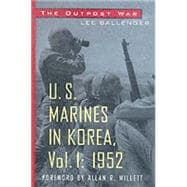Lee Ballenger's The Outpost War tells the story of the division's move to the Jamestown Line in western Korea where the assault -- trained and -- equipped troops must dig in and learn to fight an unusual defensive war. It describes their steep, deadly learning curve and reports on major battles of the period, including Bunker Hill and The Hook, while including the trials and tribulations of individuals who were there. The author's use of official archival sources blended with oral accounts places the reader in the battle line with the marines. Nearly all the material in The Outpost War has never been published before.








